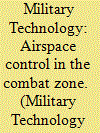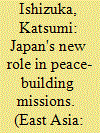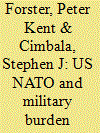| Srl | Item |
| 1 |
ID:
122673


|
|
|
|
|
| Publication |
2012.
|
| Summary/Abstract |
The airspace of the combat zone is a crucial part of the battlespace and is used by all components of the joint and multinational forces. A high con- centration of friendly surface, sub- surface, and air-launched weaponsystems must share this airspace without unnecessarily hindering the application of combat power.
The primary goal of combat zone airspace control is to enhance the combat effectiveness of the joint force. Airspace control includes coordinating, integrating, and regulating airspace to increase
operational effectiveness
|
|
|
|
|
|
|
|
|
|
|
|
|
|
|
|
| 2 |
ID:
077274


|
|
|
| 3 |
ID:
154333


|
|
|
|
|
| Summary/Abstract |
NATO burden sharing has become an especially timely issue in the past several years as a result of a number of factors, including Russian annexation of Crimea and destabilization of eastern Ukraine in 2014. This article argues that alliance unity among the great democracies of Europe and North America is indispensable to peace and stability on the Eurasian continent. A fractured NATO, and especially, a large divide in purposes or commitments as between the United States and its European security partners, invites aggression and the possibility of inadvertent escalation. Past successes and failures in US-involved multinational peace and stability operations, within and outside of Europe, show that mission accomplishment requires give and take, including the occasional acceptance of unequal costs and benefits among the members, in order to achieve peace and security objectives.
|
|
|
|
|
|
|
|
|
|
|
|
|
|
|
|
| 4 |
ID:
138097


|
|
|
|
|
| Summary/Abstract |
The United States uses two forms of multilateralism to increase levels of foreign public support for military action: diplomatic multilateralism and operational multilateralism. Diplomatic multilateralism is typically done by obtaining a United Nations Security Council resolution authorizing military action. The use of multinational forces, the so-called coalition of the willing and many flags program, is an example of operational multilateralism. While scholars have empirical evidence that diplomatic multilateralism generates foreign domestic support for the use of force, there is no equivalent study for operational multilateralism. We do not know if or how much the two types of multilateralism would differ in inducing foreign domestic support for military action. This article, by using Japan as a field of survey experiment, answers these questions.
|
|
|
|
|
|
|
|
|
|
|
|
|
|
|
|